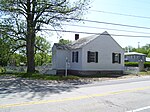Providence County, Rhode Island
1703 establishments in Rhode IslandCounties in Greater BostonPages with non-numeric formatnum argumentsPopulated places established in 1703Providence County, Rhode Island ... and 3 more
Providence metropolitan areaRhode Island countiesUse mdy dates from December 2021

Providence County is the most populous county in the U.S. state of Rhode Island. As of the 2020 census, the county's population was 660,741, or 60.2% of the state's population. Providence County contains the city of Providence, the state capital of Rhode Island and the county's (and state's) most populous city, with an estimated 190,934 residents in 2020. Providence County is included in the Providence-Warwick, RI-MA Metropolitan Statistical Area, which in turn constitutes a portion of the greater Boston-Worcester-Providence, MA-RI-NH-CT Combined Statistical Area. As of 2010, the center of population in Rhode Island is located in Providence County, in the city of Cranston.
Excerpt from the Wikipedia article Providence County, Rhode Island (License: CC BY-SA 3.0, Authors, Images).Providence County, Rhode Island
James Street,
Geographical coordinates (GPS) Address Nearby Places Show on map
Geographical coordinates (GPS)
| Latitude | Longitude |
|---|---|
| N 41.87 ° | E -71.58 ° |
Address
James Street
James Street
02828
Rhode Island, United States
Open on Google Maps









